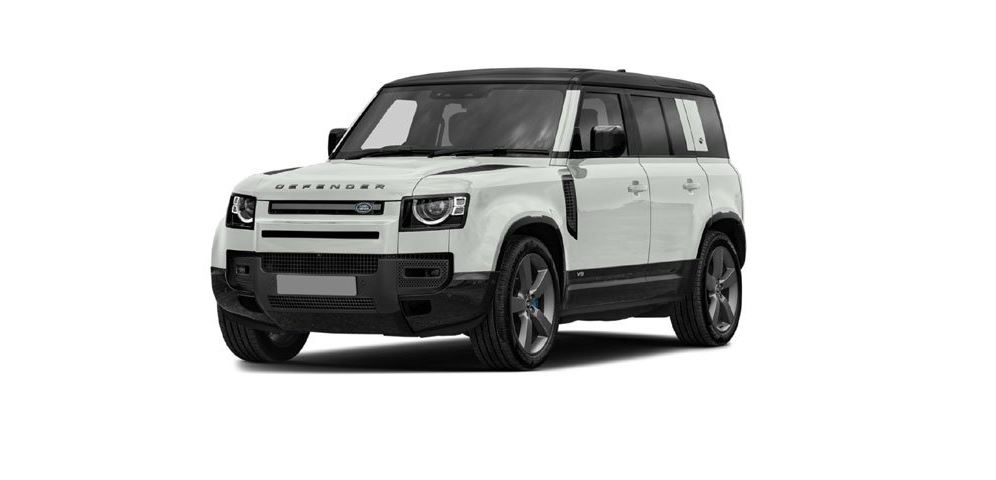 2023 Land Rover Defender Child Safety
2023 Land Rover Defender Child Safety
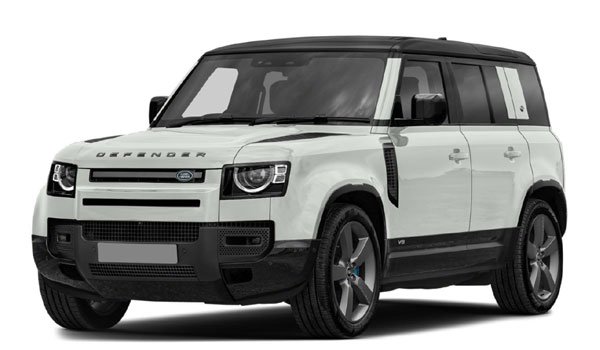
CHILD SEAT SAFETY
Make sure to read and fully understand the relevant warnings before using any of the features in this section. Failure to observe warnings and cautions may result in vehicle damage, injury, or DEATH in the event of an accident.
- Always follow the child seat manufacturer’s instructions that accompany the child seat carefully.
- Always use a child restraint or booster seat appropriate to the age and size of a child.
- Always wear seat belts or use suitable child restraints, for every trip, no matter how short.
- Always securely store a head restraint, if removing it in order to fit a child restraint.
- Always refit a removed head restraint after a child restraint is removed.
- Always make sure the child restraint is correctly anchored.
- Never use a forward-facing child restraint until the child using it is above 9 kg (20 lb), and able to sit up unaided. Up to the age of two, a child’s spine and neck are not sufficiently developed to avoid injury in a frontal impact.
- Never allow a baby or infant to be held or carried on the lap. The force of a crash can increase effective body weight by as much as thirty times, making it impossible to hold onto the child.
- Never use a child seat that only hooks over the seatback. A child seat of this type cannot be satisfactorily secured and is unlikely to be safe for a child.
- It may not be possible to fit three child seats at the same time to the rear seats. If larger child seats are used, it may only be possible to fit two child seats to the rear seats.
CHILD SEAT OVERVIEW
Make sure to read and fully understand the relevant warnings before using any of the features in this section. See CHILD SEAT SAFETY.
All infants and children should be restrained in a suitable child safety seat. The child safety seat should be appropriate to the age and size of the infant or child.
CHILD SEAT POSITIONING
Make sure to read and fully understand the relevant warnings before using any of the features in this section. See CHILD SEAT SAFETY.
Crash statistics show that children are safest when properly secured in a child restraint system appropriate for the age and weight of the child, in a rear seating position. Failure to use an appropriate restraint system greatly increases the risk of serious injury or death in the event of an accident.
The ages given are approximate. If in doubt, the child’s weight, not age, should be used when considering an appropriate child seat.
The legislation which governs how and where children should be carried when traveling in a vehicle is subject to change. The driver is responsible for making sure that all regulations in force are complied with.
BOOSTER SEATS
Make sure to read and fully understand the relevant warnings before using any of the features in this section. See CHILD SEAT SAFETY.
A child may be too large to fit into a child safety seat, but too small to safely fit the vehicle’s seat belt. In these circumstances, it is recommended that a booster seat is used for maximum safety. Follow the manufacturer’s instructions for the fitting and use of the booster seat. Adjust the vehicle’s seat belt accordingly.
If the booster seat is fitted with i-Size or ISOFIX connectors, these should be used to secure the seat in conjunction with the rear seat belt.
CHILD RESTRAINT CHECKLIST
Make sure to read and fully understand the relevant warnings before using any of the features in this section. See CHILD SEAT SAFETY.
Every time a child travels in the vehicle, observe the following:
- Use appropriate child restraints.
- Carefully follow the instructions provided by the manufacturer of the restraint system.
- Adjust the harness for every child on every journey.
- Make sure that all slack is removed from the adult seat belt.
- Make sure that any seat belt positioning sliders are adjusted so there is no slack in the belt after fastening.
- Always attach the top tether when fitting an i-Size or ISOFIX child seat, if applicable to the seat type.
- Always check the security of the child restraint.
- Avoid dressing the child in bulky clothing. Do not place any objects between the child and the restraint system.
- Regularly check the fit and condition of the child seat. If the fit is poor, or wear or damage is visible, replace the restraint immediately.
- Set a good example and always wear a seat belt.
- For child seats fitted with a support leg, adjust the leg so that it rests firmly on the floor of the vehicle.
- The center rear seat may not be suitable for use with child seats that feature a support leg that rests on the floor. Refer to the child seat manufacturer’s information.
- If the vehicle’s head restraints interfere with the fitment of a child restraint, remove the head restraint and stow securely. Always replace the head restraint when the child restraint is removed.
- If a child restraint is provided with a lap belt guide it should be used as per the child restraint manufacturer’s instructions.
- The third-row seat is not suitable for use with child seats that feature a support leg that rests on the floor.
Care must be taken not to load any part of the child seat when repositioning the front seat. The space available for front seat occupants is reduced by the fitment of a rearward-facing child seat in the rear.
CHILD SAFETY INFORMATION
Make sure to read and fully understand the relevant warnings before using any of the features in this section. See CHILD SEAT SAFETY.
Children should travel in the rear of the vehicle at all times. Front passenger seat travel is not recommended.
Extreme hazard! Never place a rearward-facing child restraint on the front passenger seat. The infant could be seriously injured or killed if the airbag deploys.
A child should only travel in the front passenger seat if it is essential and national or state legislation permits it. If this is the case, it is recommended that the following preparations are made before fitting the child restraint:
- Disable the front airbag. See DISABLING THE PASSENGER AIRBAG.
- Adjust the seat to the rearmost position.
- Adjust the seat cushion to the highest position.
- Adjust the seatback to the optimum upright position to support the child seat.
- Adjust any lumbar support to the minimum support position.
- Adjust any cushion extenders to the fully retracted position.
CHILD SAFETY LOCKS
Make sure to read and fully understand the relevant warnings before using any of the features in this section. See CHILD SEAT SAFETY.
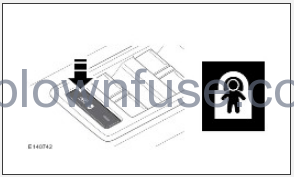
The rear door interior handles should be disabled if children are to be carried in the rear seat positions.
Press the button located on the driver’s door to activate the child door locks and inhibit the rear windows. The LED indicator illuminates when active. The instrument panel displays a confirmation message.
To switch off, press the button again. The LED extinguishes. The instrument panel displays a confirmation message.
WARNING LABELS
Make sure to read and fully understand the relevant warnings before using any of the features in this section. See CHILD SEAT SAFETY.
Extreme Hazard! Do not use a rearward-facing child restraint on a seat protected by an airbag in front of it!
NEVER use a rearward facing child restraint on a seat protected by an ACTIVE AIRBAG in front of it, DEATH or SERIOUS INJURY to the CHILD can occur.
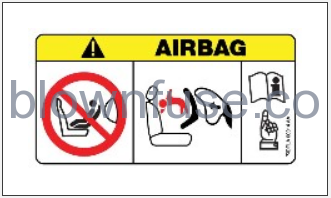
The above label is affixed to the passenger side sun visor. The label warns against the use of a rearward-facing child seat in the front passenger’s seat, when a front passenger airbag is fitted and operational.
Never let a child’s head rest near to a front seat side airbag, as an inflating airbag can cause serious or fatal injury.
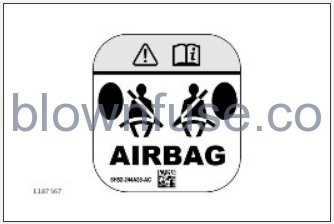
The above label is affixed to both B pillars. The label warns against a child sitting too close to the front seat side airbag.
DO NOT carry babies, infants or children in the front passenger seat. NEVER use rearward facing child restraint systems on a seat protected by an ACTIVE AIRBAG in front of it, DEATH or SERIOUS INJURY to the CHILD may occur.
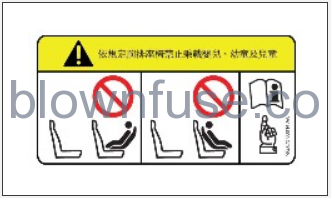
The above label is affixed to the passenger’s side sun visor. The label warns against the use of a rear-facing child seat in the front passenger’s seat, when a front passenger airbag is fitted and operational.
CHILD SEAT REFERENCE TABLES
Make sure to read and fully understand the relevant warnings before using any of the features in this section. See CHILD SEAT SAFETY.
The information contained within the tables is correct at the time of going to press. However, the availability of child restraints may change. Please consult a retailer/authorized repairer for the latest recommendation.
The information contained in the following tables may not be applicable to all countries. If there is any doubt regarding the type and fitment of child seats, seek advice from a retailer/authorized repairer.
| Seating positions | Mass group | ||||
|---|---|---|---|---|---|
| 0 = Up to 10 kg 0 to 9 months | 0+ = Up to 13 kg 0 to 18 months | I = 9 to 18 kg 9 months to 4 years | II = 15 to 25 kg 4 to 9 years | III = 22 to 36 kg 8 to 12 years | |
| Front passenger seat with airbag ON | X | X | UF | UF | UF |
| Front passenger seat with airbag OFF* | U | U | U | U | U |
| Front center seat | X | X | X | X | X |
| Second row outboard seats** | U | U | U | U | U |
| Second row center seat** | U | U | U | U | U |
| Third row outboard seats*** | X | X | UF | UF | UF |
| Third row center seat | X | X | X | X | X |
U = Suitable for universal category restraints, approved for this mass group.
X = Not suitable for the use of child restraints in this mass group.
UF = Suitable for universal forward-facing child restraints in this mass group. However, it is recommended that children are secured in an approved child seat, secured in a rear seating position.
* Always make sure the passenger airbag has been disabled before using a child restraint in this seating position. See DISABLING THE PASSENGER AIRBAG.
When using a child restraint in the front passenger seat:
- The seat should be positioned fully rearward.
- The seat cushion should be raised to its highest position.
- The seat back should be adjusted to an upright position to support the child’s restraint.
**For vehicles fitted with adjustable second-row seats:
- Adjust the seatback to the upright position to support the child restraint.
- Adjust the seat to the mid-fore-aft position. The seat can however be adjusted to provide space for third-row seat occupants, or to accommodate a large child seat, if required.
***For vehicles fitted with third row seats:
- Adjust the second row seatback to the upright position. Move the seat forward to give sufficient clearance to allow fitment of the third row child restraint.
- Child seats fitted with a support leg are not suitable for use in the third row.
| Mass group as shown on child restraint | Fixtures and size class | Front passenger with airbag ON | Front passenger with airbag OFF* | Front center seat | Recommended child restraint system |
|---|---|---|---|---|---|
| Carrycot | ISO/L1 F | X | X | X | – |
| ISO/L2 G | X | X | X | – | |
| 0 Up to 10 kg (0-9 months) | ISO/R1 E | X | IL | X | BeSafe iZi CombiX4 ISOfix. |
| 0+ Up to 13 kg (0-18 months) | ISO/R1 E | X | IL | X | |
| ISO/R2 D | X | IL | X | – | |
| ISO/R3 C | X | IL | X | – | |
| I 9-18 kg (9 months to 4 years) | ISO/R2 D | X | IL | X | – |
| ISO/R3 C | X | IL | X | – | |
| ISO/F2 B | IUF | IUF | X | BeSafe iZi CombiX4 ISOfix. | |
| ISO/F2X B1 | IUF | IUF | X | ||
| ISO/F3 A | IUF | IUF | X | ||
| II/III 15-36 kg (4 to 12 years) | – | IL | IL | X | Jaguar Land Rover – Group II and III child seat or Britax Römer KIDFIX M i-Size OEM. |
| Mass group as shown on child restraint | Fixtures and size class | Second** and third*** row outboard seats | Second and third row center seats | Recommended child restraint system |
|---|---|---|---|---|
| Carrycot | ISO/L1 F | X | X | – |
| ISO/L2 G | X | X | – | |
| 0 Up to 10 kg (0-9 months) | ISO/R1 E | IL | X | BeSafe iZi CombiX4 ISOfix. |
| 0+ Up to 13 kg (0-18 months) | ISO/R1 E | IL | X | |
| ISO/R2 D | IL | X | – | |
| ISO/R3 C | IL | X | – | |
| I 9-18 kg (9 months to 4 years) | ISO/R2 D | IL | X | – |
| ISO/R3 C | IL | X | – | |
| ISO/F2 B | IUF | X | BeSafe iZi CombiX4 ISOfix. | |
| ISO/F2X B1 | IUF | X | ||
| ISO/F3 A | IUF | X | ||
| II/III 15-36 kg (4 to 12 years) | – | IL | X | Jaguar Land Rover – Group II and III child seat or Britax Römer KIDFIX M i-Size OEM. |
IUF = Suitable for ISOFIX forward-facing child restraint systems of a universal category, approved for use in this mass group.
IL = Suitable for installation of an ISOFIX child seat in the Semi-Universal category providing that the vehicle is included on the approved list of vehicles supplied by the child seat manufacturer.
X = ISOFIX position not suitable for ISOFIX child restraint systems in this mass group and/or this size class.
*Always make sure the passenger airbag has been disabled before using a child restraint in this seating position. See DISABLING THE PASSENGER AIRBAG.
When using a child restraint in the front passenger seat:
- The seat should be positioned fully rearward.
- The seat cushion should be raised to its highest position.
- The seat back should be adjusted to an upright position to support the child restraint.
**For vehicles fitted with adjustable second row seats:
- Adjust the seatback to the upright position to support the child seat.
- Adjust the seat to the mid fore-aft position. The seat can however be adjusted to provide space for third row seat occupants, or to accommodate a large child seat, if required.
ISOFIX anchor points are not provided in the second row centre seating position.
ISOFIX child restraints should be securely attached, following the manufacturer’s instructions.
***For vehicles fitted with three seats in the third row:
- Adjust the second row seatback to the upright position. Move the seat forward to give sufficient clearance to allow fitment of the third row child restraint.
- Child seats fitted with a support leg are not suitable for use in the third row.
| Seating positions | |||||
|---|---|---|---|---|---|
| Front passenger with airbag ON | Front passenger with airbag OFF* | Front center seat | Second** and third*** row outboard seats | Second and third row center seats | |
| i-Size child restraint systems | i-UF | i-U | X | i-U | X |
i-UF = Suitable for forward-facing i-Size universal child restraint systems only.
i-U = Suitable for forward or rearward-facing i-Size universal child restraint systems.
X = Not suitable for i-Size universal child restraint systems.
*Always make sure the passenger airbag has been disabled before using a child restraint in this seating position. See DISABLING THE PASSENGER AIRBAG.
When using a child restraint in the front passenger seat:
- The seat should be positioned fully rearward.
- The seat cushion should be raised to its highest position.
- The seat back should be adjusted to an upright position to support the child restraint.
**For vehicles fitted with adjustable second row seats:
- Adjust the seatback to the upright position to support the child seat.
- Adjust the seat to the mid fore-aft position. The seat can however be adjusted to provide space for third-row seat occupants, or to accommodate a large child seat, if required.
i-Size anchor points are not provided in the second-row center seating position.
i-Size child restraints should be securely attached, following the manufacturer’s instructions.
***For vehicles fitted with three seats in the third row:
- Adjust the second-row seatback to the upright position. Move the seat forward to give sufficient clearance to allow fitment of the third-row child restraint.
- Child seats fitted with a support leg are not suitable for use in the third row.
FITTING ISOFIX AND I-SIZE CHILD RESTRAINTS
- Make sure to read and fully understand the relevant warnings before using any of the features in this section. See CHILD SEAT SAFETY.
- Do not attempt to fit ISOFIX or i-Size child restraints to the rear center seating positions. The anchor bars are not designed to hold an ISOFIX or i-Size child restraint in this position. The child could be endangered in a crash if the child restraint is not properly secured in the vehicle.
- If removing a head restraint in order to fit a child restraint, always secure the head restraint when storing it. Always refit a removed head restraint after the child restraint is removed. The child could be endangered in a crash if the child restraint is not properly secured in the vehicle.
- WARNING: child restraint anchorages are designed to withstand only those loads imposed by correctly fitted child restraints. Under no circumstances are they to be used for adult seat belts, harnesses, or for attaching other items or equipment to the vehicle.
- If the child restraint is not correctly anchored, there is a significant risk of injury to the child in the event of a collision or emergency braking.
The front seat ISOFIX and i-Size fitment is not standard and is market/derivative specific.
ISOFIX and i-Size child restraints can be fitted in the following locations:
- The front passenger seat (not available in all markets).
- Second row outboard seats.
- Third row outboard seats.
NOTES
Third row child restraints are only applicable where the third row has three seats.
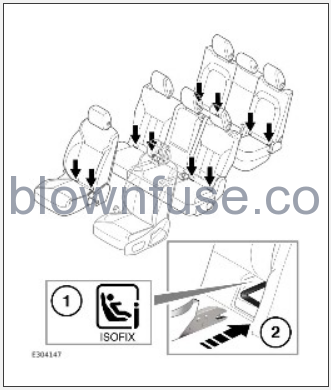
To install an ISOFIX or i-Size child restraint:
- A label displaying the ISOFIX and i-Size symbol is sewn into the flaps covering the lower anchor bars or on the seats close to the lower anchor bars. The label indicates the position of the ISOFIX or i-Size anchorages. Slide the child seat into position and attach the locking mechanism to the ISOFIX or i-Size anchor bars.
Some child restraints are fitted with an upper tether anchorage. See FITTING TETHER ANCHORAGE CHILD RESTRAINTS.
Test the security of the child restraint. To do this, attempt to pull the restraint away from the vehicle’s seat and twist the restraint from side to side. Even if the restraint appears secure, the anchor points should be checked visually, to make sure they are correctly attached.
Always make sure that if an upper tether is provided, it is fitted and tightened correctly.
For child restraints fitted with a support leg, adjust the leg so that it rests firmly on the floor.
After removing a child restraint, always make sure the lower anchor bar flap is fully closed. Failure to fully close a flap could hinder a seat fold maneuver.
FITTING TETHER ANCHORAGE CHILD RESTRAINTS
- Make sure to read and fully understand the relevant warnings before using any of the features in this section. See CHILD SEAT SAFETY.
- Always follow the child seat or restraint system manufacturer’s instructions when fitting tether straps. The child could be endangered in a crash if the child restraint is not properly secured.
- If removing a head restraint in order to fit a child restraint, always secure the head restraint when storing it. In the event of an accident, an unsecured object could cause serious injury.
- If a child seat or restraint system is to be fitted to the center seating position, the center armrest must be in the stored position (folded into the seat). In the event of an accident, an unsecured object could cause serious injury.
- Tether anchorage points are fitted to the back of all passenger seating positions. Each tether anchorage point is for the sole use of a child restraint fitted to the same seat.
Do not attach a tether strap to an anchorage point on a folded seat.
Always use the tether anchorage provided with your child seat or restraint system. The tether anchorage should be correctly routed and tightened.
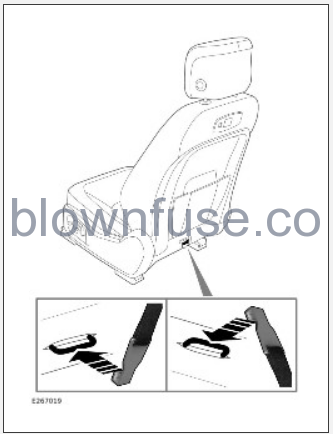
- Fit the child restraint securely in the front passenger seat.
- Raise the head restraint.
- Pass the tether strap(s) under the head restraint, between the two head restraint stems.
- Attach the tether strap hook to the anchor point on the back of the same seat. Make sure the strap is not twisted, and that the hook is facing towards the back of the seat.
The anchor point is located behind a flap in the seat trim. The flap is identified by a label. When fitting a child restraint for the first time, the perforations around the flap must be broken to allow access to the anchor point.
In certain cases, depending on the design of the tether strap hook, it may be necessary to fit the tether strap hook from above. This may result in a single twist in the strap which is acceptable.
- Tighten the tether strap(s) according to the child seat manufacturer’s instructions.
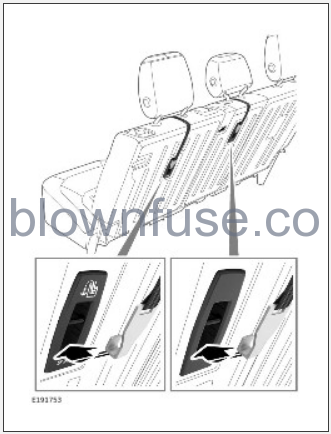
- Fit the child restraint securely in a second-row seat.
- Pass the tether strap(s) under the head restraint, between the two head restraint stems.
- Attach the tether strap hook to the anchor point on the back of the same seat. Make sure the strap is not twisted, and that the hook is facing toward the back of the seat.
- Tighten the tether strap(s) according to the child seat manufacturer’s instructions.
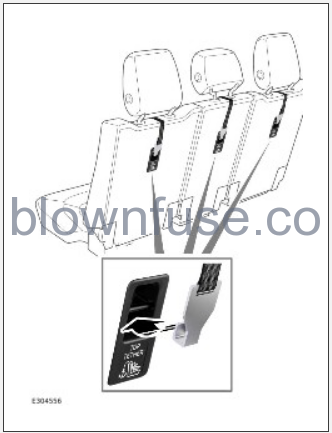
Vehicles with two seats in the third row have tether anchorages in similar positions.
- Fit the child restraint securely in a third-row seat.
- Pass the tether strap(s) under the head restraint, between the two head restraint stems.
- Attach the tether strap hook to the anchor point on the back of the same seat. Make sure the strap is not twisted, and that the hook is facing toward the back of the seat.
- Tighten the tether strap(s) according to the child seat manufacturer’s instructions.
RECOMMENDED CHILD SEATS
Make sure to read and fully understand the relevant warnings before using any of the features in this section. See CHILD SEAT SAFETY.
| Child size and age | Recommended seats | |
|---|---|---|
| i-Size and ISOFIX positions | Non-i-Size and non-ISOFIX positions | |
| Groups 0 and 0+ | BeSafe iZi CombiX4 ISOfix. | Maxi Cosi Cabriofix. |
| Group I | BeSafe iZi CombiX4 ISOfix. | Britax Römer Duo Plus. |
| Groups II and III | Jaguar Land Rover – Group II and III child seat or Britax Römer KIDFIX M i-Size OEM. | Jaguar Land Rover – Group II and III child seat or Britax Römer KIDFIX M i-Size OEM. |
